Science-fiction writer, occultism buff and sensationalist ufologist Jimmy Guieu indicates that after he published his novel "Our Ancestors of the Future" in January 1956, he received a bulky amount of mail from puzzled readers who pressed him to explain the exact significance of the epigraph of the title page of his book.
The "epigraph" in question was addressed to "the one" who had been contacted seven times by a "being" from Space and who owned a material proof of these contacts, and invited him to read the book and to renew contact with the author.
Jimmy Guieu ensures that it was not an advertising scheme but a true call so that the person renews contact.
He then explains that the story of this person was never told so far and will seem being a pure fabrication to "some", but that it came to him from a "person absolutely worthy of faith" of which he is "forced" to conceal the identity, like that of the witness.
He tells that an investigator of Ouranos, his ufology group, a "technician", received in March 1955 a letter from a pensioner living in city "X" 150 kilometers from city "Y" where the investigator resided. The letter requested this investigator to meet the author to give him "confidential information of the uttermost importance."
The investigator met that person, who told that he occupies his pensioner's leisure in painting, frequently in the countryside around the city, and one day of March 1955, whereas he painted a landscape, he was amazed to see a circular object of aluminum color which slowed down in the sky, started to go down slowly vertically into the clearing where he had installed his painter's rest.
The man ensures he had "never hitherto placed faith into the lies about the alleged flying saucers" and that was thus very amazed.
He says that the craft was eight to ten meters in diameter, was surmounted by "a kind of dome", landed about fifty meters of him, a "kind of door" opened slowly and a "human" (between quotation marks) came out, covered of a greyish or brown "flight suit", with a helmet "a little similar to that of the pilots of airplanes." He then says to have realized that it was a young woman "of a great beauty" whose blonde wicks exceeded the lower edges and sides of the helmet.
He says he gave up his brushes and walked to her, whereas she stood in front of her craft, looking at him "with interest, smiling." The young woman also took some steps towards him, stopped at 5 or 6 meters "of the periphery of the disc" while he stood clumsily in front of her "still under the blow of an intense emotion." She smiled even more, looked around her, picked up small stones and lined them up two by two on the ground between them, forming "ten stone pairs."
The "Uranian" - old fashioned French ufology term for saucer occupants who came from the skies - then pointed a finger at him, then at her, then at the first pair of stones, then the other pairs stones, then herself, then various points of the horizon, and the man understood that she had established ten similar contacts with ten different people "in other places from France or other countries."
He made gestures so that she understood that he wished to visit "her strange lenticular apparatus" but she shook head smiling and told words which he could not understand, in "a pleasant voice with soft inflections."
Guieu then remarks that these details are "strangely" reminiscent with those of the encounter between George Adamski and a "Venusian."
The Uranian made gestures meaning that she would return three days later at the same place, they exchanged "a series of gestures - comic undoubtedly." She beckoned to him to move back, reinstated her craft, "the hatchway was closed again on her" and the "discoid vehicle" slowly rose with a deaf humming sound, accelerated and "soon disappeared" in the sky.
The man remained there upset then went home, wondering whether he had dreamed, but all was so clear, so precise in his memory that he "hesitated to believe" that it had been an hallucination. He returned each day to the same place with his painter's equipment, but was so nervous and upset that he could not paint.
The third day, the flying disc returned, the young gracious and smiling woman emerged, and thus seven times in March and April 1955, with the man wishing to visit the saucer but in vain, except at the last encounter.
He specified that he had noticed that she never walked far from her craft, and that it was perhaps because she was protected by "a force field or a radiation undetectable to us".
The man says that he was certain she came from outer space because in several encounters she had pointed the sky, her craft, then herself.
He explains that he did everything so that she gave him material proof, that she should trust him since he came alone at the meeting each time, as she had asked him by gesture and mimicry at the first encounter.
At the last meeting, she invited him inside the saucer, where there was "a kind of cockpit made out of shining metal", surmounted of a plate in half-moon shape of approximately 1 m 50 of ray on which were luminous dots connected to each other by dark lines. The cockpit's walls "as well as the parquet floor" were out of metal. On the transparent "half-moon" were three large buttons laid out in triangle, "command buttons, no doubt", The colored "dots" connected by dark lines, "by an effect of perspective", seemed suspended in the "in-depth" vacuum in or behind the transparent plate.
The Space Lady then gave him "a weird device", implying he could keep it, and showing him how to make use of it.
Jimmy Guieu reports that the investigator, at this time of the interview, "looked at his interlocutor with insistence" wondering whether he was a mythomaniac telling his "visions", or whether it was true, but that the man "however did not have the type of a mystifier" and told his story quietly, "without agitation or abnormal exaltation." "His gestures were measured, his tone was quiet, and all, in his attitude and his behavior, showed solid common sense."
The investigator told him "I do not want to insult you by denying your statement", and after that the man took out of a small suitcase "a kind of television receiver tube", a cylindro-conical object shining like polished aluminum, approximately 45 centimeters long, 20 centimeters diameter at one end and 6 to 8 centimeters elsewhere.
The investigator, "in his capacity as a technician", was strongly intrigued when he checked the 2.5 to 3 kilos device and, "amazed, noted that the metal in the cone... turned into a kind of glass or opalescent matter! In other words, the molecular and atomic building of the metal was modified."
Guieu then indicates that in the current state of our technical knowledge, no laboratory of the Earth could have produced such "a transmutation", and that the device thus came from supra-advanced beings "from another world!"
The investigator and the man drove y car onto a mountain and the man explained that the device was a "telescope with automatic focus", of an extraordinary clearness, with a roller to be turned towards the right for magnifying, on the left for a larger field of vision. The investigator tests it, and, claims Guieu, could see the registration number and traces of dirty oil of a cabin of a cable car located 17 kilometers away.
Returned downtown, the two men agreed to meet again and go at the next rendez-vous with the Space Lady, who conveniently agreed now that her contact brings a friend along. But 15 days later, the man wrote to the investigator: he is in bed with pneumonia, he will get in touch once cured.
Hearing no news, the investigator goes to see the man, but the latter had "purely and simply disappeared!"
In February 1956, the investigator was visited by relative of the "missing" man, who "reiterating the instructions of discretion as for the identity of the interested" explained that the man was visited by four "rather mysterious" men who "discussed lengthily with him." after that a "greatest distress" seized upon him and he disappeared the hurriedly the next morning, movin at another relative's "in another area of France", and since, refused to give his new address to the investigator, "is not interested any more in flying saucers" and "takes great care not to tackle this topic of conversation in the new city where he hides!"
Jimmy Guieu then lengthily rambles about these four men, explaining they were "Men-in-Black" like those who "visited Albert K. Bender in the U.S.A." with the same result, and concludes that "the solution of this irritating enigma is perhaps out of our range..., outside Earth! "
|
|
[Ref. jg1:] JIMMY GUIEU:
Jimmy Guieu indicates that after he published his novel "Our Ancestors of the Future" in January 1956, he received a bulky amount of mail from puzzled readers who pressed him to explain the exact significance of the epigraph of the title page of his book.
The "epigraph" in question was addressed to "the one" who had been contacted seven times by a "being" from Space and who owned a material proof of these contacts, and invited him to read the book and to renew contact with the author.
Jimmy Guieu ensures that it was not an advertising scheme but a true call so that the person renews contact.
He then explains that the story of this person was never told so far and will seem being a pure fabrication to "some", but that it came to him from a "person absolutely worthy of faith" of which he is "forced" to conceal the identity, like that of the witness.
He tells that an investigator of Ouranos, his ufology group, a "technician", received in March 1955 a letter from a pensioner living in city "X" 150 kilometers from city "Y" where the investigator resided. The letter requested this investigator to meet the author to give him "confidential information of the uttermost importance."
The investigator met that person, who told that he occupies his pensioner's leisure in painting, frequently in the countryside around the city, and one day of March 1955, whereas he painted a landscape, he was amazed to see a circular object of aluminum color which slowed down in the sky, started to go down slowly vertically into the clearing where he had installed his painter's rest.
The man ensures he had "never hitherto placed faith into the lies about the alleged flying saucers" and that was thus very amazed.
He says that the craft was eight to ten meters in diameter, was surmounted by "a kind of dome", landed about fifty meters of him, a "kind of door" opened slowly and a "human" (between quotation marks) came out, covered of a greyish or brown "flight suit", with a helmet "a little similar to that of the pilots of airplanes." He then says to have realized that it was a young woman "of a great beauty" whose blonde wicks exceeded the lower edges and sides of the helmet.
He says he gave up his brushes and walked to her, whereas she stood in front of her craft, looking at him "with interest, smiling." The young woman also took some steps towards him, stopped at 5 or 6 meters "of the periphery of the disc" while he stood clumsily in front of her "still under the blow of an intense emotion." She smiled even more, looked around her, picked up small stones and lined them up two by two on the ground between them, forming "ten stone pairs."
The "Uranian" [old fashioned French ufology term for saucer occupants who came from the skies] then pointed a finger at him, then at her, then at the first pair of stones, then the other pairs stones, then herself, then various points of the horizon, and the man understood that she had established ten similar contacts with ten different people "in other places from France or other countries."
He made gestures so that she understood that he wished to visit "her strange lenticular apparatus" but she shook head smiling and told words which he could not understand, in "a pleasant voice with soft inflections."
Guieu then remarks that these details are "strangely" reminiscent with those of the encounter between George Adamski and a "Venusian."
The Uranian made gestures meaning that she would return three days later at the same place, they exchanged "a series of gestures - comic undoubtedly." She beckoned to him to move back, reinstated her craft, "the hatchway was closed again on her" and the "discoid vehicle" slowly rose with a deaf humming sound, accelerated and "soon disappeared" in the sky.
The man remained there upset then went home, wondering whether he had dreamed, but all was so clear, so precise in his memory that he "hesitated to believe" that it had been an hallucination. He returned each day to the same place with his painter's equipment, but was so nervous and upset that he could not paint.
The third day, the flying disc returned, the young gracious and smiling woman emerged, and thus seven times in March and April 1955, with the man wishing to visit the saucer but in vain, except at the last encounter.
He specified that he had noticed that she never walked far from her craft, and that it was perhaps because she was protected by "a force field or a radiation undetectable to us".
The man says that he was certain she came from outer space because in several encounters she had pointed the sky, her craft, then herself.
He explains that he did everything so that she gave him material proof, that she should trust him since he came alone at the meeting each time, as she had asked him by gesture and mimicry at the first encounter.
At the last meeting, she invited him inside the saucer, where there was "a kind of cockpit made out of shining metal", surmounted of a plate in half-moon shape of approximately 1 m 50 of ray on which were luminous dots connected to each other by dark lines. The cockpit's walls "as well as the parquet floor" were out of metal. On the transparent "half-moon" were three large buttons laid out in triangle, "command buttons, no doubt", The colored "dots" connected by dark lines, "by an effect of perspective", seemed suspended in the "in-depth" vacuum in or behind the transparent plate.
The Space Lady then gave him "a weird device", implying he could keep it, and showing him how to make use of it.
Jimmy Guieu reports that the investigator, at this time of the interview, "looked at his interlocutor with insistence" wondering whether he was a mythomaniac telling his "visions", or whether it was true, but that the man "however did not have the type of a mystifier" and told his story quietly, "without agitation or abnormal exaltation." "His gestures were measured, his tone was quiet, and all, in his attitude and his behavior, showed solid common sense."
The investigator told him "I do not want to insult you by denying your statement", and after that the man took out of a small suitcase "a kind of television receiver tube", a cylindro-conical object shining like polished aluminum, approximately 45 centimeters long, 20 centimeters diameter at one end and 6 to 8 centimeters elsewhere.
The investigator, "in his capacity as a technician", was strongly intrigued when he checked the 2.5 to 3 kilos device and, "amazed, noted that the metal in the cone... turned into a kind of glass or opalescent matter! In other words, the molecular and atomic building of the metal was modified."
Guieu then indicates that in the current state of our technical knowledge, no laboratory of the Earth could have produced such "a transmutation", and that the device thus came from supra-advanced beings "from another world!"
The investigator and the man drove y car onto a mountain and the man explained that the device was a "telescope with automatic focus", of an extraordinary clearness, with a roller to be turned towards the right for magnifying, on the left for a larger field of vision. The investigator tests it, and, claims Guieu, could see the registration number and traces of dirty oil of a cabin of a cable car located 17 kilometers away.
Returned downtown, the two men agreed to meet again and go at the next rendez-vous with the Space Lady, who conveniently agreed now that her contact brings a friend along. But 15 days later, the man wrote to the investigator: he is in bed with pneumonia, he will get in touch once cured.
Hearing no news, the investigator goes to see the man, but the latter had "purely and simply disappeared!"
In February 1956, the investigator was visited by relative of the "missing" man, who "reiterating the instructions of discretion as for the identity of the interested" explained that the man was visited by four "rather mysterious" men who "discussed lengthily with him." after that a "greatest distress" seized upon him and he disappeared the hurriedly the next morning, movin at another relative's "in another area of France", and since, refused to give his new address to the investigator, "is not interested any more in flying saucers" and "takes great care not to tackle this topic of conversation in the new city where he hides!"
Jimmy Guieu then lengthily rambles about these four men, explaining they were "Men-in-Black" like those who "visited Albert K. Bender in the U.S.A." with the same result, and concludes that "the solution of this irritating enigma is perhaps out of our range..., outside Earth! "
[Ref. go1:] GODELIEVE VAN OVERMEIRE:
The Belgian ufologist indicates that in March 1955 in a place not specified in France, a painter wishing to keep the most strict anonymity was busy painting a landscape, and saw a circular craft of aluminum color slowing down and going down vertically and land in the clearing where the painter's rest was installed. The craft had 8 to 10 meters in diameter, was surmounted by a dome, and was within 50 meters of the witness. A kinf of door opened slowly and he saw a person come down, dressed in a greyish or brownish suit and capped of a helmet.
After having better looked, he noticed that the being was a woman of great beauty, with fair wicks exceeding the lower edges and the sides of the helmet. She looked at him, smiling, took some steps, but remained within 5 or 6 meters of her craft. She picked up a certain number of small stones which she lined up two by two on the ground between them.
There were 10 stone pairs. She pointed a finger at him, and at the first stone pair. She pointed the other stone pairs and pointed herself, and various points of the horizon. The witness believed to understand that she had established contacts with 10 different people.
He expressed his desire to visit the craft, but she answered in unintelligible words and it seemed to him that she promised to return three days later. The witness thus came back wondering whether he had dreamed, but he went to the rendez-vous with the mysterious women on the 3rd day, and she came.
In April and March, they met 7 times, but it was only the last time that the witness could visit the craft. She also agreed to his wish for some palpable proof, and that day he received a kind of cylindro-conical object shining like aluminum, 45 cm long, 20 cm broad at the great base and 6 to 8 cm in the small base, which weighed approximately 2.5 kg.
When kept in hand, the metal changed into a kind of glass or opalescent matter, and it was actually very powerful telescope, not requiring any focussing, making it possible to see clearly even at objects 17 kilometers away.
Little time after the visit which the investigator made to the witness, the latter fell sick and had to flee, chased by 4 men in black who did not leave him any peace. The witness literally "disappeared."
Godelieve van Overmeire comments that this disappearance is "after all, the most elegant way for an author of fiction to come out of the embarrassment... and to avoid an investigation."
Godelieve van Overmeire indicates that the source is Jimmy Guieu in "Black-out sur les S.V.", Fleuve noir, 1956, pages 245 à 253.
[Ref. ar1:] ALBERT ROSALES:
Albert Rosales indicates in his catalogue that in France, exact location not given, on March, 1955, in the evening, the witness, a painter, was occupied painting the landscape when he noticed a circular silvery machine slowly coming down in a vertical descent into a nearby clearing. The object was about 8 to 10 m in diameter, topped by a dome, and was about 50 meters from the witness. A type of door opened slowly and a person wearing a gray brown combination suit and a helmet descended to the ground. After taking a closer look at the being the witness noticed that it was a woman, of great beauty, with fair wicks of hair exceeding the lower edges and the sides of the helmet. She was smiling and remained 5 to 6 meters from the object. The woman then collected a certain number of small stones, which she aligned, two by two on the ground between her and the witness. There were 10 stone pairs. She pointed her index finger towards the witness, and then the to first stone pair. She indicated to the other stone pairs and pointed to herself and then to various points of the horizon. The witness understood that this meant that she has established contacts with 10 other people. The witness expressed his desire to visit the object, but she answered in incomprehensible words and the witness understood that she promised to return three days later. The witness return later and again encountered the landed object and its female occupant. This time he was given tangible proof of the encounter in the form of a 45 cm cylinder shaped metallic object that weighted about 2.5 kg. As he held the object it transformed itself into a kind of opalescent matter. He was supposedly able to see great distances when he looked through the object. A later visit to the site by the investigator and the witness caused the witness to become sick and leave the area. He was later supposedly harassed by mysterious strangers dressed in black and soon after disappeared, his whereabouts unknown.
Albert Rosales indicates that the source is Jimmy Guieu, "Blackout of the Flying Saucers".
Albert Rosales comments that it is a contact case with direct interference.
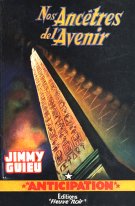
|
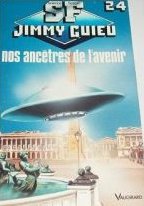
|
Left: "Nos Ancêtres de l'Avenir", ("Our Ancestors from the Future"), an adventure of the recurring character Jean Kariven, by Jimmy Guieu, 1956, tells of a struggle between the "Polarians" and the Humans, who fail to make peace because all the government leaders of the Earth are under the spell of "psychotronic devices" of the "Denebians", evil beings, thirsty for blood and power. |
Henri-Rene Guieu, aka Jimmy Guieu, Dominique Verseau, Claude Rostaing, Jimmy G. Quint, (1926-2000) was impassioned with occultism, ghosts, the paranormal and parapsychology before getting a "flying saucers expert" as soon as 1947. He was mostly a writer of science fiction and occult adventures novels, even erotica, producing books by the dozens; true ancestors of modern TV series such as the X-Files. Extremely credulous, mistaking meteors for flying saucers unceasingly, living in a world of his own, he also published without really checking into them all kinds of stories of flying saucers sightings, and sometimes, as it is the case here, had only little scruple to mix fiction and reality, taking as a starting point the topics of the rising "lunatic fringe" in US ufology, such as the topics of his correspondent Gray Barker, with his beautiful Venusian blondes and mysterious "men in black" always there to "pressure witnesses" so that the long sought "hard evidence" disappear "mysteriously" form every far-fetched accounts.
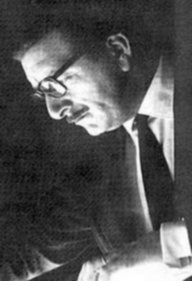 Jimmy Guieu. |
Jimmy Guieu "enchanted" generations of readers, science-fiction buffs and UFO buffs, some of them taking it all with a grain of salt while others still scream all hell when one dares to disbelieve such stories.
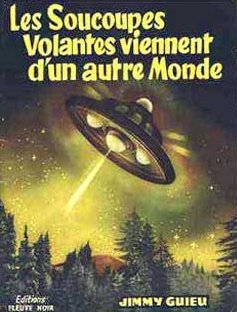
|
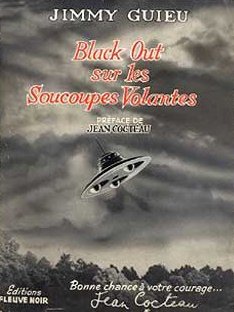
|
|
"Adamski saucer" on the two flying saucers books by Jimmy Guieu. |
|
| Id: | Topic: | Severity: | Date noted: | Raised by: | Noted by: | Description: | Proposal: | Status: |
|---|---|---|---|---|---|---|---|---|
| None. | ||||||||
Ufologist invention, "contactees"-inspired.
* = Source I checked.
? = Source I am told about but could not check yet. Help appreciated.
| Main Author: | Patrick Gross |
|---|---|
| Contributors: | None |
| Reviewers: | None |
| Editor: | Patrick Gross |
| Version: | Created/Changed By: | Date: | Change Description: |
|---|---|---|---|
| 0.1 | Patrick Gross | February 8, 2008 | Creation, [jg1], [ar1], [go1]. |
| 1.0 | Patrick Gross | February 8, 2008 | First published. |